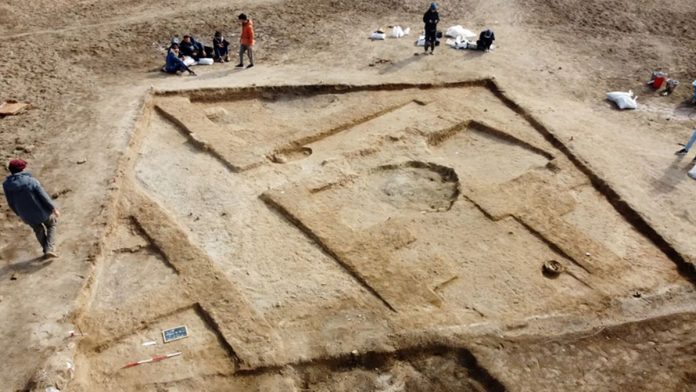Archaeologists in southern Iraq have uncovered the remains of a restaurant dating back nearly 5,000 years they hope will illuminate the lives of ordinary people in the world’s first cities.
The United States (US)-Italian team made the find in the ruins of ancient Lagash, northeast of the modern city of Nasiriyah, which was already known to have been one of the first urban centres of the Sumerian civilisation of ancient Iraq.
The joint team from the University of Pennsylvania and the University of Pisa discovered the remains of a primitive refrigeration system, a large oven, benches for diners and around 150 serving bowls. Fish and animal bones were found in the bowls which was widespread among the Sumerians.
“So we’ve got the refrigerator, we’ve got the hundreds of vessels ready to be served, benches where people would sit… and behind the refrigerator is an oven that would have been used… for cooking food,” project director Holly Pittman told AFP. “What we understand this thing to be is a place where people, regular people, could come to eat and that is not domestic,” she said.
The world’s first cities developed in what is now southern Iraq, after agricultural surpluses from the domestication of the first crops allowed the emergence of new social classes not engaged directly in food production.
The Lagash area, close to the confluence of the Tigris and Euphrates rivers, was dubbed the “garden of the gods” by the ancients for its fertility and gave rise to a string of Sumerian cities dating back to the early dynastic period.
“Lagash was one of the important cities of southern Iraq,” Iraqi archaeologist Baker Azab Wali told AFP, after working with the US-Italian team on the site.
“Its inhabitants depended on agriculture, livestock, fishing, but also on the exchange of goods,” he said. Pittman said the team was eager to learn more about the occupations of the people who used the restaurant in its heyday to throw new light on the social structure of the first cities.
Detailed analysis would need to be carried out on the samples taken during the excavations the team completed in November.
“There is so much that we do not know about this early period of the emergence of cities and that is what we are investigating,” she said.
“We hope to be able to characterise the neighbourhoods and the kinds of occupation… of the people that lived in this big city who were not the elite,” she added.
“Most of the work done at the other sites focusses on kings and priests. And that is all very important but the regular people are also important.”
According to a report, the Archaeologists found benches, an oven and food remnants dating back to 2700 B.C.E.
Archaeologists have unearthed the remains of an ancient tavern that’s nearly 5,000 years old in southern Iraq, the University of Pennsylvania announced last week. The find offers insight into the lives of everyday people who lived in a non-elite urban neighborhood in southwest Asia around 2700 B.C.E.
Inside the public eating space—which included an open-air area and a kitchen—researchers with the University of Pennsylvania and the University of Pisa found an oven, a type of clay refrigerator called a zeer, benches and storage containers that still held food. They also found dozens of conical-shaped bowls that contained the remains of fish, reports CNN’s Issy Ronald.
The tavern was discovered at Lagash, a 1,000-acre archaeological site that was a bustling industrial hub with many inhabitants during the Early Dynastic period. Researchers say Lagash was one of the largest and oldest cities in all of southern Mesopotamia.
“The site was of major political, economic and religious importance,” says Holly Pittman, an archaeologist at the University of Pennsylvania and the Lagash project director, in a statement from the university. “However, we also think that Lagash was a significant population center that had ready access to fertile land and people dedicated to intensive craft production.”
Researchers have been conducting the most recent round of Lagash excavations since 2019, but work at the site dates back to the 1930s. Over the past four years, researchers have used an array of high-tech techniques to better understand the site, including capturing drone imagery and conducting magnetometry analysis. They’ve also collected and studied sediment samples from as deep as 80 feet below the surface to understand the site’s geological and geophysical evolution over the years.
“It’s not like old-time archaeology in Iraq,” says Zaid Alrawi, project manager for the Lagash project at the Penn Museum, in the statement. “We’re not going after big mounds expecting to find an old temple. We use our techniques and then, based on scientific priority, go after what we think will yield important information to close knowledge gaps in the field.”
To investigate the ancient tavern just 19 inches below the surface, the archaeologists used a technique that involves excavating thin horizontal sections one by one. Discovering the tavern suggests that the society at Lagash included a middle class, in addition to enslaved individuals and elites.
“The fact that you have a public gathering place where people can sit down and have a pint and have their fish stew, they’re not laboring under the tyranny of kings,” says Reed Goodman, an archaeologist at the University of Pennsylvania, to CNN. “Right there, there is already something that is giving us a much more colorful history of the city.”
The researchers’ other discoveries at the site include an area where the city’s ancient inhabitants once made pottery, complete with six ceramic kilns, benches and a table. They also found a domestic dwelling that contained a toilet and a kitchen.
“As you excavate, you analyze and create a story that we hope gets closer and closer to the reality of the past,” says Alrawi in the statement.













